Aggressive Inline Skates Purchase Guide

Aggressive skating focuses on creativity and artistic expression. Your selection of aggressive skates will significantly influence your skating adventure. Here, we have collected a host of helpful tips and advice for anyone considering purchasing new aggressive inline skates.
Overview
Overview
Sizing Aggressive Inline Skates
When choosing the size for aggressive skates, it's crucial to understand that selecting a model based on your shoe size isn't enough. It's necessary to bring out your tape measure to determine the precise length of your longest foot.
Once your foot length is measured accurately, finding the perfect fit becomes straightforward. Each specific model of aggressive skates on our homepage features a size guide that lets you find the correct size according to your foot length. These size guides measure in millimetres, applying the Mondopoint-system for simple conversion between sizes.
Measuring Your Foot

- Stand on a firm, level surface.
- Wear the socks you plan to skate in.
- Place a sheet of paper flush with the wall.
- Stand with your heel against the wall and foot flat on the paper.
- Mark where your longest toe ends on the paper.
- Measure from the wall or the end of the paper to the mark.
- Repeat for both feet and use the larger measurement for your skate size.
What is the Proper Fit for Aggressive Skates?
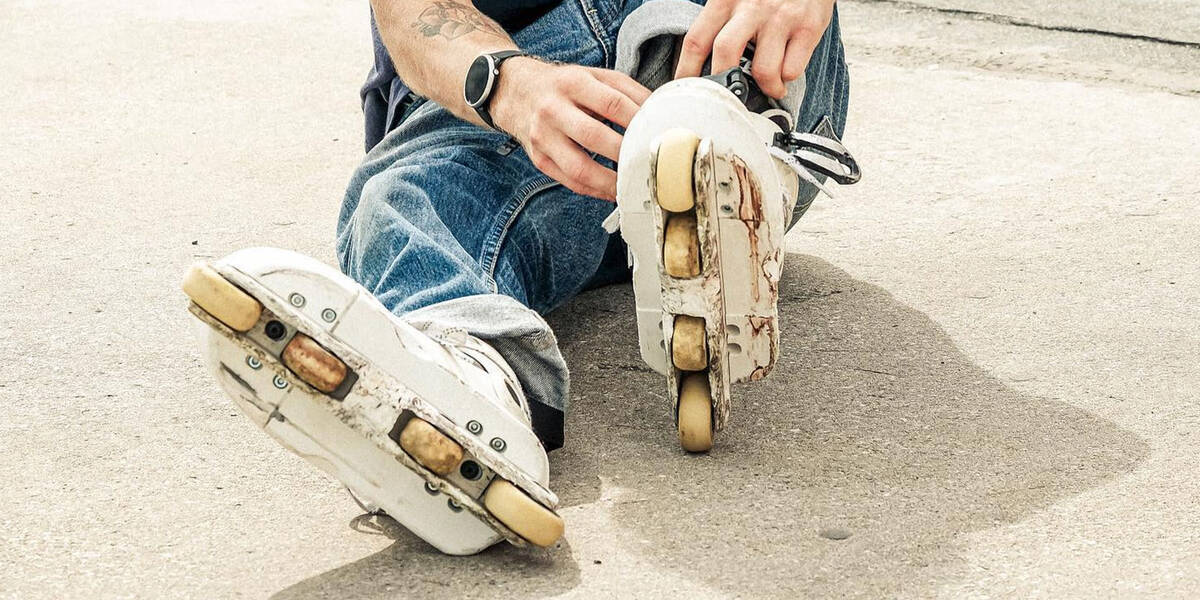
Aggressive skates need to fit tightly around your foot to allow maximum control during manoeuvres. If trick skates are too roomy, your feet may shift within the boot, resulting in blisters and less control. Larger skates add weight, making tricks more demanding.
In summary: A snug fit is essential for high performance, but your foot and toes shouldn't be cramped.
Breaking In Aggressive Skates
Initially, new aggressive skates might require a period of wearing in before they become comfortable. Remember, they should fit tightly, and over time, the liner will mould to your foot's specific shape.
Here are some suggestions for breaking in aggressive skates:
- Use thick socks to lessen friction and prevent blisters.
- Wear the skates while doing varied activities to get accustomed to them.
- Start with brief sessions, lengthening them gradually.
- Make sure laces and buckles are fastened correctly for a comfortable fit.
A significant advantage of aggressive skates is the replaceable liners, ensuring comfort as they wear.
Anatomy of Aggressive Skates – What Exactly Are Aggressive Skates?

- Boot: Aggressive skates are equipped with hard boots or shells.
- Frame: Robust frames designed to withstand grinding and hard landings.
- Wheels: Smaller wheels for enhanced stability and control.
- Soul plate: Enhances grind variety with a dedicated grind surface.
- H-block: Central to facilitating grinding.
Aggressive skates are purposely designed for tricks, grinds, and jumps in urban environments and skateparks, transforming all types of obstacles into potential features for fresh tricks and exploration. These skates specialise in grinding – no other skate type matches their grinding capability.
Such skates boast smaller wheels than other inline skates, reducing the centre of gravity and boosting control. This feature heightens agility and manoeuvrability, ideal for multiple tricks. While beneficial for tricks, if you aim to commute, go longer distances, participate in rapid urban skating, or seek fitness-focused skating, consider skates with larger wheels.
Selecting Aggressive Skate Wheels

Vital elements of aggressive wheels include wheel diameter, hardness, and profile. These significantly influence your skating performance.
Each element can be customised to align with your skating style and the terrain you frequently encounter, thereby optimising your aggressive skate experience.
Diameter of Aggressive Skate Wheels
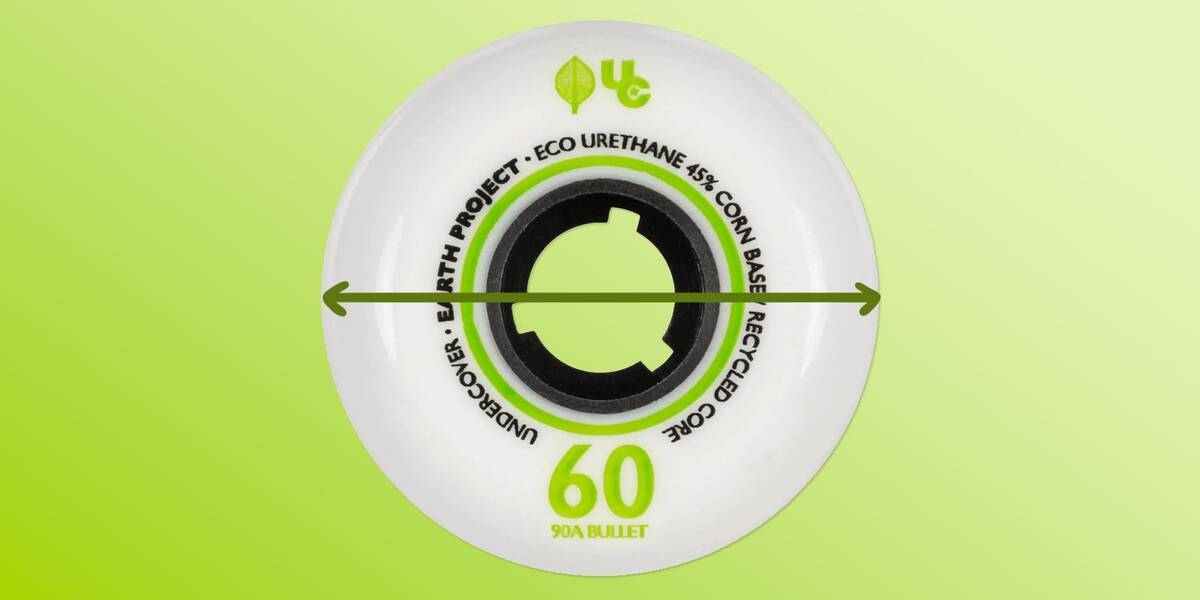
The usual diameter for these wheels ranges from 56 to 60 mm, but can vary from 54 to 80 mm.
- Larger wheels (60-80 mm): Offer more speed but less stability, complicating technical tricks.
- Smaller wheels (56-58 mm): Provide greater stability but are slower.
If seeking skates with standard-sized wheels, models with 58 or 60 mm wheels are advisable.
Profile of Aggressive Skate Wheels

Aggressively designed wheels typically feature a flat profile, though some may have more round or pointed profiles.
- Flat profile: Increases stability and ease of control during landings.
- Rounded profile: Enhances agility with reduced grip, lessening the likelihood of wheels snagging on rails.
- Pointy profile: Provides increased speed and easier turning with less friction (less common in aggressive skating).
For trick-heavy aggressive skating, flat profile wheels are recommended. For a touch of added agility and speed, consider a rounder profile.
The Hardness of Aggressive Skate Wheels
Wheel hardness is assessed on the durometer scale, typically ranging from 86A to 95A. A higher durometer indicates harder wheels.
- Harder wheels: Quicker on smooth surfaces, absorbing less vibration, presenting challenges on rough surfaces. They ease sliding and reduce wheel bite during grinds.
- Softer wheels: Provide more stability, better vibration absorption, and greater grip.
Weigh up the pros and cons of harder versus softer wheels and consider your own skating style and preferences.
Wheel Configurations on Aggressive Skates
Aggressive skates are configured with either a flat or anti-rocker wheel setup. These define the shape traced by the wheel's underside when mounted. Wheel configuration dramatically affects the riding experience, making it key when choosing new aggressive inline skates.
Understanding Anti-Rocker Setups
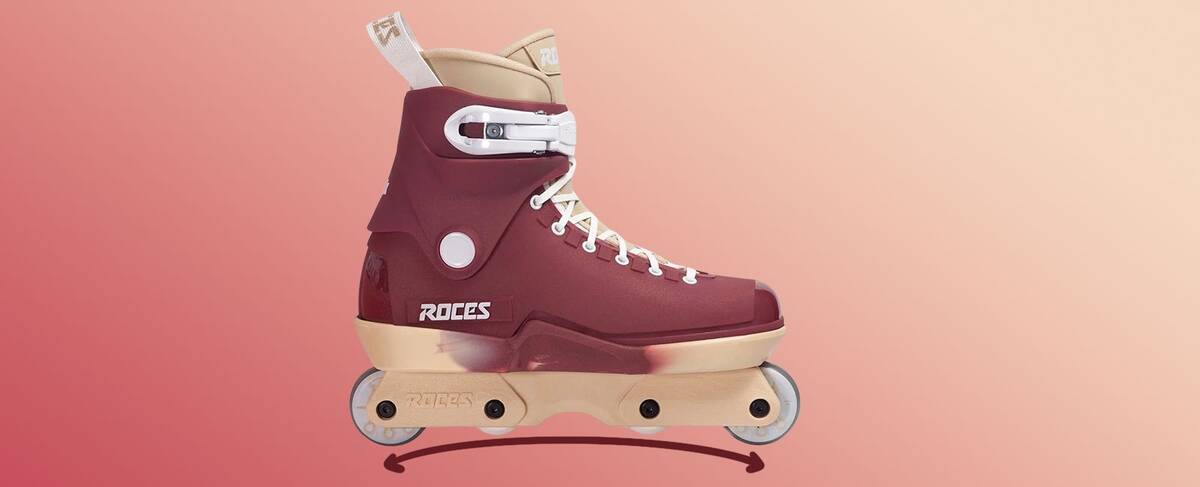
Anti-rocker arrangements involve larger front and rear wheels, with smaller middle wheels to provide space for grinds. They're less responsive than flat setups. Their two-point contact increases the challenge of turning compared to flat or rocker setups. If an anti-rocker setup feels too restrictive yet you wish to maintain focus on grinding and aggressive skating, a flat wheel setup might suit you better.
Explaining Anti-Rocker Wheels
Anti-rocker wheels are the two smaller middle wheels in an anti-rocker setup on aggressive skates, often harder than the outer wheels and not in contact with the ground when rolled. They prevent interference during grinds while aiding in locking onto various grinds. They're typically crafted from a hard PU formula that resists sticking to rails.
Named for their diminutive size, creating a distinctive upward groove between the ground and wheels, they contrast with rocker setups, where slightly smaller outer wheels than middle ones facilitate a rocking motion.
Do Anti-Rocker Wheels Require Bearings?
Bearings in anti-rocker wheels can be beneficial for stair bashing, as they allow smooth rolling down stairs. Dubbed grind wheels, their main role in aggressive skates is to prevent the wheels from sticking during grinds on H-blocks, so bearings are unnecessary for anti-rocker wheels. Some include bearings, others do not.
What Defines a Flat Setup in Aggressive Skates?
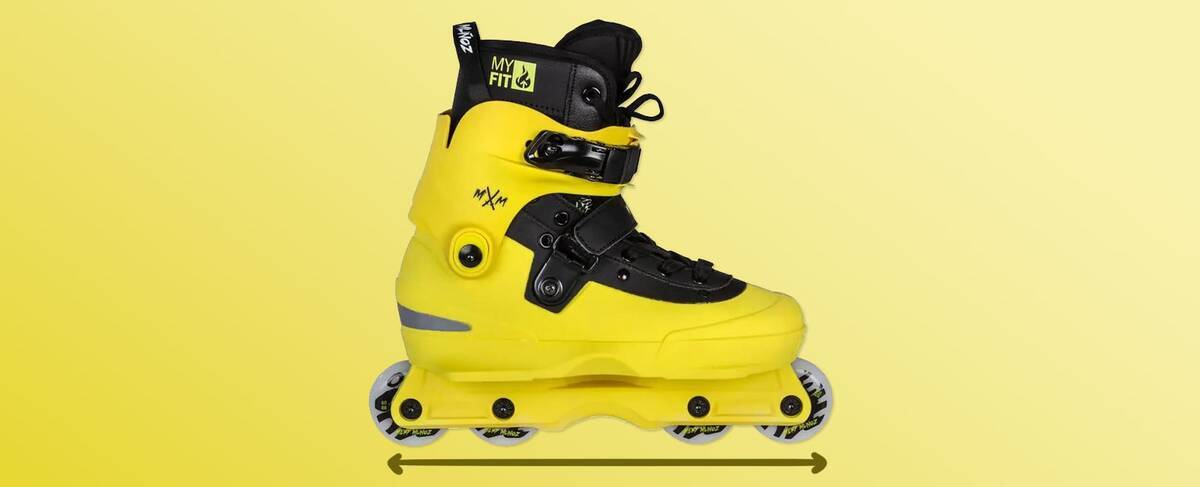
Flat setups feature wheels of the same size, enhancing speed and manoeuvrability over anti-rocker setups. Precision is required for groove grinds due to the increased risk of middle wheels catching the rail. Not all frames accommodate flat setups due to space involved for middle wheels.
If you're a novice in inline skating and venturing into aggressive skating, a flat setup is strongly advised. Many seasoned aggressive skaters also prefer flat setups for the style and precision required when grinding H-blocks.
Flat vs. Anti-Rocker
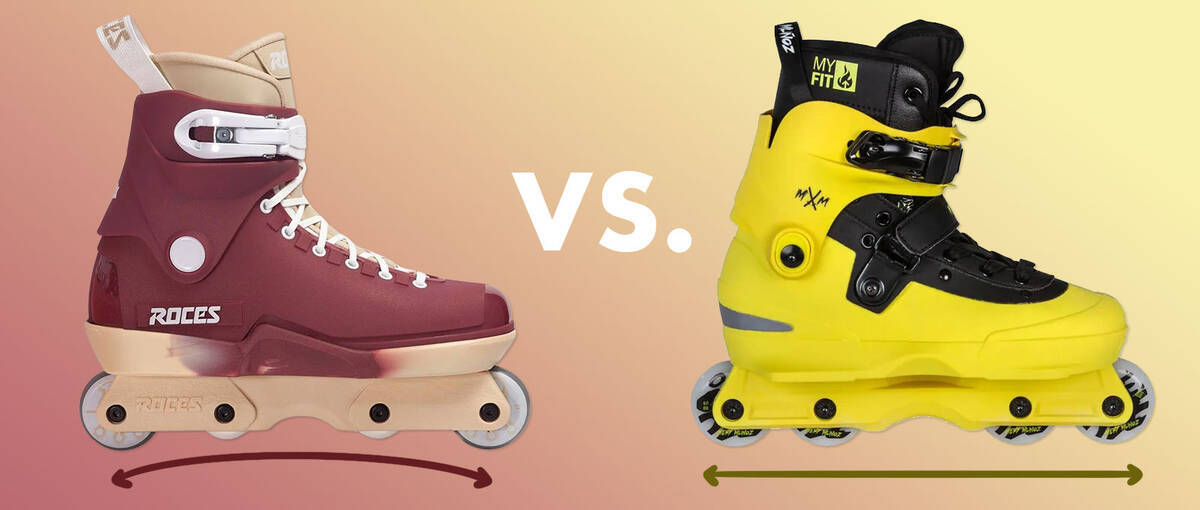
Whether novice or expert, the choice between anti-rocker or flat setup hinges on personal preference. Neither is superior.
If purchasing new skates and uncertain which to select, consider:
- Groove Grinds with Anti-Rocker: Smaller wheels reduce grip during H-block grinds.
- Groove Grinds with Flat Setups: Require more precision, potentially leading to more stylish grinds.
- Speed: Higher in flat setups than anti-rocker.
- Maneuverability: Turning in flat setups is more graceful, improving smoothness in bowls and parks.
- Beginners on Inline Skates: Flat setups ease learning to skate.
- Beginners on Aggressive Skates: Anti-rocker setups simplify learning to grind. For those experienced with inline skating, anti-rocker setups can be favoured for easier grinding.
Ultimately, your choice should reflect your unique skating style, priorities, and whether you're completely new to inline skates or experienced and transitioning to aggressive skates.
The Frames of Aggressive Skates

Frames in aggressive skates serve two main purposes: securely fastening the wheels and offering a platform for grinds. As grinding is integral to aggressive skating, paying attention to frames is key when selecting the best aggressive skates for you.
Aggressive skate frames are built from resilient materials like aluminium, fibreglass, or composites to endure the demands of aggressive skating. Almost all comply with the Universal Frame System (UFS), ensuring they fit with any brand of aggressive boots.
Certain aggressive frames are crafted for a distinct wheel setup, whilst others can host a variety of configurations. Should you acquire skates featuring a flat wheel alignment, you have the option to transform them to an anti-rocker arrangement by fitting smaller wheels in the centre, thereby boosting your grinding proficiency.
It's not every frame that is suitable for a flat setup, thus transitioning from an anti-rocker setup to a flat arrangement necessitates meticulous planning. Employing a calliper to measure the space available can determine its viability, although consulting the manufacturer's specifications might be simpler. Verify that the frames are listed as being compatible with a flat setup, then check the maximum wheel diameter and procure a set of eight wheels that are equal to or smaller than the frame's specified maximum wheel diameter.
Exploring the Universal Frame System
Any UFS frame can be exchanged with another, irrespective of brand or size.
Thanks to the broad adoption of the Universal Frame System (UFS), replacing worn-out frames becomes a straightforward task, helping to maintain the durability and performance of your skates over time.
The Universal Frame System (UFS) serves as the standard for fitting frames and boots on aggressive skates. With UFS, you can create a personalised aggressive skate setup by pairing various boots and frames. Altering frames on a UFS boot is uncomplicated, owing to the consensus among aggressive skate manufacturers on this standard.
Details of the Universal Frame System (UFS)
- Gap Between Mounting Holes: 167mm
- UFS Mounting Hole Size: 20mm
- Depth of UFS Mounting Hole: 3mm
- Width of UFS Frame: 41mm
- Method of Mounting: The frames secure via two bolts inserted into the mounting holes
The length of UFS bolts varies among frames. While the gap between mounting holes is uniform across models, UFS does not dictate frame length.
Understanding Soul Plates

Soul plates, integral to aggressive skates, are specially crafted for grinding and safeguarding the skates against wear. Positioned between the frames and the boots of aggressive skates, these plates are constructed from robust plastic materials.
They play a crucial role in the skate's performance, facilitating smooth grinds across diverse surfaces. The soul grind, among the first a beginner learns, involves the foot nearest to the rail grinding on the soul plate, while the other leg stretches forward to grind on the H-block. A primary challenge for those new to aggressive skating is getting the soul plate securely locked onto a kerb or rail.
Bearings for Aggressive Skates
The bearings housed within aggressive skate wheels are vital for ensuring seamless rotation. Due to the rigorous impacts inherent in aggressive skating, bearings require frequent replacement to sustain peak performance and perform stunts effectively. New bearings deliver a smooth roll, which is essential for executing tricks with precision. Replacement bearings are readily available as spare parts.
At SkatePro, we classify bearings using the ABEC scale, which spans from 1 to 9 and evaluates bearing precision. An elevated ABEC rating typically signifies a smoother rolling sensation.
It's notable that an ABEC rating doesn't reflect the longevity of a bearing. Hence, it is advisable to opt for bearings from well-regarded brands instead of solely relying on the ABEC rating.
Are Aggressive Skates Suitable for Inline Skating Beginners?
For those with no former inline skating experience, aggressive skates could be a viable choice, provided your aim is to delve into aggressive skating. For interests in fitness, freeride, marathons, or other inline disciplines, considering an alternative skate type would be wiser. However, if you aim to embark on aggressive blading, your inaugural pair should be aggressive skates. Several factors merit attention:
- Stability: Aggressive skates, with their smaller wheels, offer heightened stability, benefiting novices in mastering the basics of inline skating.
- Surface: These skates aren't best suited for rough or irregular terrains due to their smaller wheels and heavier design, a primary reason aggressive skates are recommended chiefly for those focusing on aggressive skating.
- Flat Setup: For those unfamiliar with inline skates, selecting aggressive skates equipped with a flat wheel setup, where all eight wheels are identical in diameter, is advantageous. This setup facilitates learning strides and provides a smoother rolling experience.
If you are uncertain about whether aggressive inline skates suit you, consider learning more about the range of inline skates and roller skates available:
